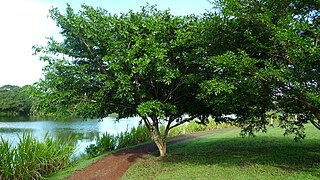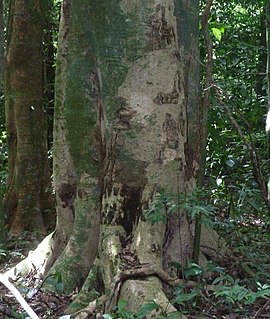
Dipteryx is a genus containing a number of species of large trees and possibly shrubs. It belongs to the "papilionoid" subfamily – Faboideae – of the family Fabaceae. This genus is native to South and Central America and the Caribbean. Formerly, the related genus Taralea was included in Dipteryx.

Leucaena is a genus of flowering plants in the mimosoid clade of the subfamily Caesalpinioideae of the family Fabaceae. It contains about 24 species of trees and shrubs, which are commonly known as leadtrees. They are native to the Americas, ranging from Texas in the United States south to Peru. The generic name is derived from the Greek word λευκός (leukos), meaning "white," referring to the flowers.

Pithecellobium dulce, commonly known as Manila tamarind, Madras thorn, or camachile, is a species of flowering plant in the pea family, Fabaceae, that is native to the Pacific Coast and adjacent highlands of Mexico, Central America, and northern South America. It is also sometimes known as monkeypod, but that name is also used for several other plants, including Samanea saman. It is an introduced species and extensively naturalized in the Caribbean and Florida, as well as the Philippines and Guam via the Manila galleons. It has also been introduced to Thailand and South Asia, It is considered an invasive species in Hawaii.

Vachellia rigidula, commonly known as blackbrush acacia or chaparro prieto, and also known as Acacia rigidula, is a species of shrub or small tree in the legume family, Fabaceae. Its native range stretches from Texas in the United States south to central Mexico. This perennial is not listed as being threatened. It reaches a height of 5–15 feet (1.5–4.6 m). Blackbrush Acacia grows on limestone hillsides and canyons.

Havardia albicans is a perennial tree of the family Fabaceae that grows to 5 meters tall. It is native to Mexico, the Caribbean and Central America, in regions around the Yucatan Peninsula. Common names for it include chucum and cuisache. It is reputed to be psychoactive.
Albizia berteriana, the Bertero albizia, is a species of plant in the family Fabaceae. It is found in Cuba, the Dominican Republic, Haiti, and Jamaica.
Pithecellobium decandrum is a species of flowering plant in the legume family, Fabaceae. It is endemic to Brazil, where it occurs in the forests of the Amazon River valley and along its tributaries.
Albizia pistaciifolia is a species of plant in the family Fabaceae. It is found in Colombia, Ecuador, and Venezuela.
Abarema acreana is a tree species in the legume family (Fabaceae). It is a rather mysterious plant and may be endemic to Brazil. Fruiting trees apparently have never been found, and thus it is not clear whether this plant belongs into the genus Abarema, or in Hydrochorea, or elsewhere.

Inga sellowiana is an endangered species of legume in the family Fabaceae, endemic to Brazil. It is an evergreen, perennial shrub or small tree, 1–8 metres (3.3–26.2 ft) in height. Common names include ingá mirim, ingá ferro, ingá xixica and ingá xixi.

Pithecellobium is a genus of flowering plants in the family Fabaceae. The generic name is derived from the Greek words πιθηκος (pithekos), meaning "ape" or "monkey," and ελλοβιον (ellobion), meaning "earring," which refers to the coiled shape of the fruit pods. Plants of the genus are known generally as blackbeads.
Chloroleucon foliolosum is a tree species in the legume family (Fabaceae). It is found in Argentina, Brazil and Bolivia.
Pithecellobium pithecolobioides, known as the granadillo de río, is a tree species in the legume family (Fabaceae).
Abarema glauca, the glaucous abarema, is a tree species in the legume family (Fabaceae). It is found in Cuba, Dominican Republic, and Venezuela. Common rural names are: caracolí, nijaguao, paují (Pittier), jijaguao, and merey montañero (Hoyos). Abarema glauca is found most easily on the east coast of Dominican Republic, in Uvero Alto, north of Punta Cana..
Pseudosamanea cubana is a tree species in the legume family (Fabaceae). It is found only in Cuba.

Zygia is a genus of flowering plants in the family Fabaceae. It belongs to the mimosoid clade of the subfamily Caesalpinioideae.

Archidendron bigeminum is a tree species in the legume family (Fabaceae). It is found in India and Sri Lanka. It is known as "kalitiya - කලටිය" in Sinhala.

Pterocarpus santalinoides is a tree species in the legume family (biology) (Fabaceae); it is locally known as mututi.

Abarema adenophora is a species of plant in the family Fabaceae. It is native to Northern South America, Costa Rica, and Nicaragua.
Abarema alexandri var. troyana is a variety of the legume A. alexandri in the family Fabaceae. It is endemic to Jamaica, where it can be found in woodland or thicket on limestone soils.











